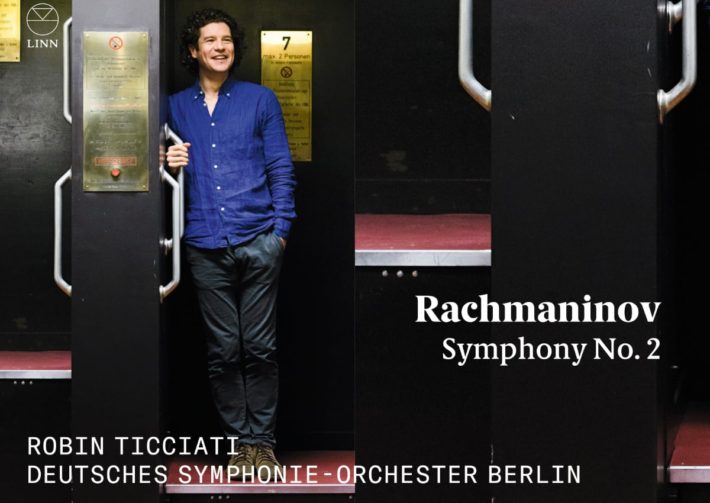The Deutsches Symphonie-Orchester Berlin has not recorded much Rachmaninov before – currently available is a recording of the composer’s second piano concerto with pianist Nobuyuki Tsujii on Challenge Classics, as well as a 1960s recording of the orchestra accompanying Margrit Weber in the Paganini Rhapsody. Yet on this new release the DSO Berlin prove themselves well-attuned to Rachmaninov’s sound world, with darkly sumptuous orchestral hues, splendidly captured by Linn’s engineers.
Ticciati’s conducting sometimes divides opinion. His keen interest in historically informed performance practice is clearly heard in his recordings of Romantic repertoire (Berlioz, Brahms, and Schumann). A recent Bruckner sixth is often too fast (especially compared to the recent [BBC Philharmonic release] on Chandos), and some might suggest his focus on clarity of line and articulation comes at the expense of emotional engagement. Like his one-time mentor Simon Rattle, Ticciati sometimes spends so much time unearthing secondary orchestral details that one loses a sense of the music’s overall structure. And indeed, there are several such moments of textural discovery in this new recording. But Ticciati’s overall conception, his sense of the music’s sprawling architecture, is very fine and his tempos, for the most part, seem unerringly right. He does observe the first movement repeat, bringing the music in at a little over 24 minutes – one of the longest performances on record. Yet with his attention to detail the reading rarely feels slow. Thankfully, Ticciati rightly encourages more vibrato than he normally allows from his strings.
The DSO Berlin’s playing is extraordinarily fine, with ripely burnished brash, warmly mellow woodwinds, and string playing of impressive finesse. Linn’s recording allows the strings to cut through even the largest brass-dominated climaxes. While the DSO strings offer plenty of rich coloration, it cannot match what is heard in the older performances led by Svetlanov and Kogan. But this is string playing of an altogether greater sophistication.
What does seem to be missing on occasion is a willingness to accept the music’s excessive emotion. In the first movement, sample at 19’33”: the contrapuntal writing is clearly laid out, revealing how Rachmaninov’s dense writing creates such a voluptuous sound. It certainly enables the listener to better appreciate the artistry of the composer’s technique. Yet Ticciati’s focus on elucidating the ‘how’ so clearly, misses the ‘why.’ Rachmaninov’s layered polyphony builds into a sweeping climax, creating an ecstatic moment that should shake us to our core. That does not quite happen here, because the performance lacks the last degree of emotional commitment found more readily in those older Russian performances, or in the more recent recordings by Litton (Bergen Philharmonic/BIS) and Petrenko (RLPO/Warner Classics).
Related Classical Music Reviews
- Review: Rachmaninoff – Symphony No. 2 – London Symphony Orchestra, Rattle
- Review: Rachmaninoff – Symphony No. 1, Symphonic Dances – Philadelphia Orchestra, Nézet-Séguin
- Review: Rachmaninov – Paganini Rhapsody, Symphony No. 3 – Abduraimov, Gaffigan
Just about every recording has a second movement timing of around 10 minutes, though on other readings the conductor is more willing to loosen the reins. Everything here is exceptionally well played, but never feels quite dangerous enough. Even at 3’28”, where Ticciati speeds up for the fugal passage, it still feels a bit over controlled.
Ticciati clearly sees the third movement as the symphony’s emotional highpoint, and the performance reaches a new level of excellence here. The opening clarinet solo is spun with seamless legato and subtle beauty (why don’t the liner notes make clear who the player is?). The entire orchestra responds to the solo with greater ardor as they build to an impressive climax at 3’14”. Ticciati and his players have a sure sense of this movement, ensuring each peak is bigger than the last.
The section that begins at 8’36” is also particularly noteworthy. Several recent performances tend to exaggerate how soft this music is meant to be played, whittling the string sound down to almost nothing. Ticciati plays it at the dynamic asked for in the score but ensures the strings still have plenty of body, and the final climax of the movement features particularly pleasing brass playing – an emotionally engaged performance of this exquisite music.
The final movement is played with power and precision, though there are moments when greater urgency and drive would not go amiss. But that is not Ticciati’s way, and one can only marvel at how beautifully he exposes the colors and complexity of Rachmaninov’s writing. He allows himself a great deal of rubato in shaping the secondary material (2’48”) and the orchestra follows him every step of the way. The coda is powerful without setting the heart racing – again, it seems an issue of holding the energy of the last climax back from propelling the music forward. But that is ultimately a matter of personal taste.
In short, a distinguished and moving performance that is more successful as an interpretation and recording that Rattle’s recent LSO album. While it may not match the emotional fervor of Litton or Petrenko, the playing and recording cannot be bettered. This is a performance that warrants repeated listening.

Rachmaninov – Symphony No. 2, Op. 27
Deutsches Symphonie-Orchester Berlin
Robin Ticciati – Conductor
Linn Records, CD CKD653
Recommended Comparisons
Read more classical music reviews or visit The Classic Review Amazon store
Follow Us and Comment:
[wd_hustle id=”HustlePostEmbed” type=”embedded”]











